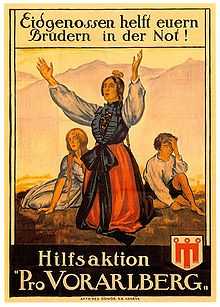Enlargement of Switzerland
The enlargement of Switzerland by way of the admission of new cantons to the Swiss Confederation ended in 1815. After a failed attempt of Vorarlberg to join Switzerland in 1919, the idea of resuming Swiss enlargement was revived in 2010 by a parliamentary motion of 28 right-wing members of the Swiss federal parliament. Their proposal would change Swiss law to allow French, German, Austrian or Italian border regions to join the Confederation, should the majority of the population in these regions request this. As possible candidates for accession, the motion names Alsace (FR), Aosta (IT), South Tyrol (IT), Jura (FR), Vorarlberg (AT), Ain (FR), Savoie (FR), Baden-Württemberg (DE), Varese (IT), Como (IT) "and others".[1]
The motion was set to be voted on in the Swiss National Council in 2010. It was greeted with derision in Swiss politics and rejected by the federal government, but has attracted the attention of the European media[2][3][4] after online polls in some of the regions concerned appeared to show widespread support for an accession to Switzerland.
History

- For a list of Swiss cantons by year of accession, see Cantons of Switzerland.
Switzerland, a multilingual federation of 26 cantons whose origins lie in a defensive alliance of alpine valleys around the end of the 13th century, has historically grown through the accession of states of varied cultural and political background (see: Growth of the Old Swiss Confederacy). The last enlargement of Switzerland occurred in 1815 with the accession of Valais, Neuchâtel and Geneva.
Subsequent enlargement proposals failed. Notably, in a 1919 referendum, 81% of the people of Vorarlberg voted to join Switzerland, but the effort failed because of the ambivalent position of the Swiss government and the opposition of the Austrian government and the Allied powers.[5]
Swiss enlargements prior to the founding of the modern federal state in 1848 were made by extending a network of treaties and alliances to the new members of the Old Swiss Confederacy. Since there is currently no legal framework governing the admission of new cantons, any enlargement would, as a matter of Swiss law, require an amendment of the Swiss federal constitution and therefore a national popular referendum.
2010 motion
The 2010 motion by members of the nationalist Swiss People's Party (SVP), Switzerland's largest and co-governing party, is mainly directed against the European Union (EU), which the SVP strongly opposes. The proposal, which was submitted by Jurassian representative Dominique Baettig and co-signed by SVP party chairman Toni Brunner, argues that the border regions are neglected by and desire autonomy from their central governments and from the EU. It proposes to offer these regions the "Swiss model of sovereignty" as an alternative to a "creeping accession" of Switzerland to the "centralist" EU.[1]
In a statement of 19 May 2010, the Swiss Federal Council recommended rejecting the motion. It argued that its adoption would be considered an unfriendly act by the countries surrounding Switzerland, and that it would also be at odds with international law, which in the government's view does not provide for a right to secession except in exceptional circumstances.[1]
No official reactions by European governments to the SVP motion were reported by June 2010; a Swiss newspaper requesting a comment by the German embassy was answered by laughter.[6] The media, however, reported on a surprisingly high level of apparent popular support for joining Switzerland (as reflected in Internet polls and comments) in some of the regions at issue:[7][8]
- In Como, an online poll in June 2010 by the La Provincia di Como newspaper found 74% of 2,500 respondents in favor of accession to Switzerland, which the local regionalist party Lega Lombarda has long been advocating.[4]
- Another online poll by the South German Südkurier newspaper found that almost 70% of respondents replied "yes, the Swiss are closer to us in outlook" to a question whether the state of Baden-Württemberg should join Switzerland. The paper noted that seldom had a topic generated so much activity by its readership.[8]
- Swiss media also recalled a 2008 poll in Vorarlberg by ORF radio, according to which about half of all Vorarlberger were in favor of joining Switzerland.[9]
- The Lombard eco-nationalist party Domà Nunch replied to Baettig's motion proposing an integration between Switzerland and the Italian border-area of Insubria in order to join into a new Confederation.[10]
See also
References
- ↑ 1.0 1.1 1.2 Erleichterte Integration grenznaher Regionen als neue Schweizer Kantone, motion 10.3215 of 18 March 2010 by Dominique Baettig.
- ↑ Maurisse, Marie (22 June 2010). "Quand un député suisse rêve d'annexer la Savoie". Le Figaro. Retrieved 22 June 2010.
- ↑ "SVP-Forderung: Vorarlberg soll Kanton werden". Der Standard. 21 June 2010. Retrieved 22 June 2010.
- ↑ 4.0 4.1 Coen, Leonardo (22 June 2010). "L'ultima tentazione di Como: "Vogliamo diventare svizzeri"". La Repubblica. Retrieved 22 June 2010.
- ↑ Low, Alfred D. (1974). The Anschluss movement, 1918-1919, and the Paris Peace Conference. American Philosophical Society. pp. 350 et seq. ISBN 978-0-87169-103-3.
- ↑ Renz, Fabian (11 June 2010). "SVP will der Schweiz Nachbargebiete einverleiben". Tages-Anzeiger. Retrieved 22 June 2010.
- ↑ "Nichts wie weg von den Pleitegeiern". Tages-Anzeiger. 22 June 2010. Retrieved 22 June 2010.
- ↑ 8.0 8.1 "Schweizer Idee sorgt für viel Wirbel". Südkurier. 19 June 2010. Retrieved 22 June 2010.
- ↑ "Jeder zweite Vorarlberger wäre lieber Schweizer". 20 Minuten. 23 October 2008. Retrieved 22 June 2010.
- ↑ "Domà Nunch rilancia: lavoriamo insieme per una confederazione elvetico-insubre". Retrieved 29 June 2010.